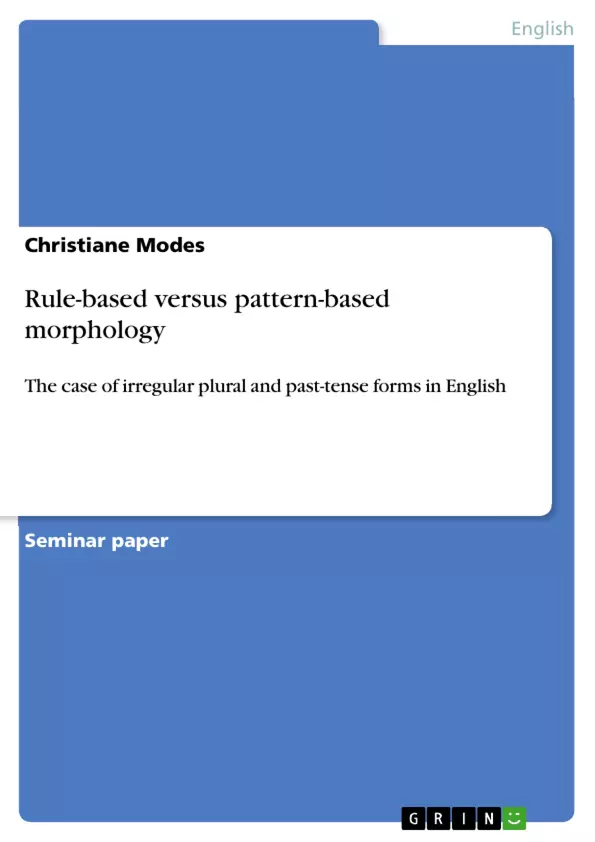This paper deals mainly with the irregular forms of morphological inflection, namely the irregular past-tense forms and the irregular plurals in English. There are obviously two different models in the field of inflectional morphology which deal with these exceptional cases in different ways: the perspectives of ruled-based and pattern-based morphology.
To describe these two approaches, a first definition should clear the most strikingly differences: in general, a rule is a given regulation to simplify and organise an action equally in each situation, to form a uniform and predictable product. A pattern is the product in reverse; it is the solution of an examination of different situations to find similarities in the process for adapting it to analogical situations. The question is: How do these approaches affect irregular inflection? Or the better question: How are they able to affect irregular plural and past-tense forms in English and where do they fail? This is up to the present a highly discussed problem in linguistics.
Chapter 2 is about two morphological models: first the morpheme-based model, that regards each product as a sum of at least two morphemes that consist of a root and an affix modifying the root. The second part will present the word-based model that analyses the whole word as such to find out similarities (Bochner 1992 21-39).
In Chapter 3 the advantages and disadvantages are discussed. Where do these models fit perfectly and in which cases do they fail or do have only partial validity?
Chapter 4 will give a short introduction of a compromise of the two models. This theory combines advantages of both rule-based and pattern-based model, to eliminate or compensate failures the models have separated.
The last chapter 5 is a conclusion to the discussed approaches, whether one model is more productive and therefore preferred. An outlook is discussed, whether a compromise or a combination of the two models is able to compensate the particular failures of each model or whether they rival to each other in a way that makes a combination impossible.
Inhaltsverzeichnis (Table of Contents)
- Introduction
- Two Morphological Models
- The Morpheme-Based Model
- The Word-Based Model
- Advantages and Disadvantages of the Two Approaches
- Advantages of the Rule-Based Approach
- Advantages of the Pattern-Based Approach
- Disadvantages of the Rule-Based Approach
Zielsetzung und Themenschwerpunkte (Objectives and Key Themes)
This paper examines the irregular forms of morphological inflection, specifically the irregular past-tense forms and irregular plurals in English. It explores how the rule-based and pattern-based models of inflectional morphology deal with these exceptions, analyzing their advantages, disadvantages, and limitations.
- Rule-based vs. pattern-based morphology
- Irregular past tense forms and plurals
- Morpheme-based model and its advantages and disadvantages
- Word-based model and its advantages and disadvantages
- Productivity and regularity in inflectional morphology
Zusammenfassung der Kapitel (Chapter Summaries)
Chapter 2 delves into two prominent models of inflectional morphology: the morpheme-based model and the word-based model. The morpheme-based model focuses on combining morphemes (root and affix) to form words, adhering to specific rules, while the word-based model stores complete words in a mental lexicon and analyzes patterns among them.
Chapter 3 analyzes the strengths and weaknesses of both approaches, exploring where they excel and where they fall short. It examines how each model handles regular and irregular inflectional forms, highlighting their limitations in dealing with exceptions.
Schlüsselwörter (Keywords)
Key themes and concepts explored in this paper include irregular inflection, morpheme-based morphology, word-based morphology, rule-based approach, pattern-based approach, productivity, regularity, mental lexicon, syncretism, and base modification.
- Quote paper
- Christiane Modes (Author), 2013, Rule-based versus pattern-based morphology, Munich, GRIN Verlag, https://www.grin.com/document/267705



